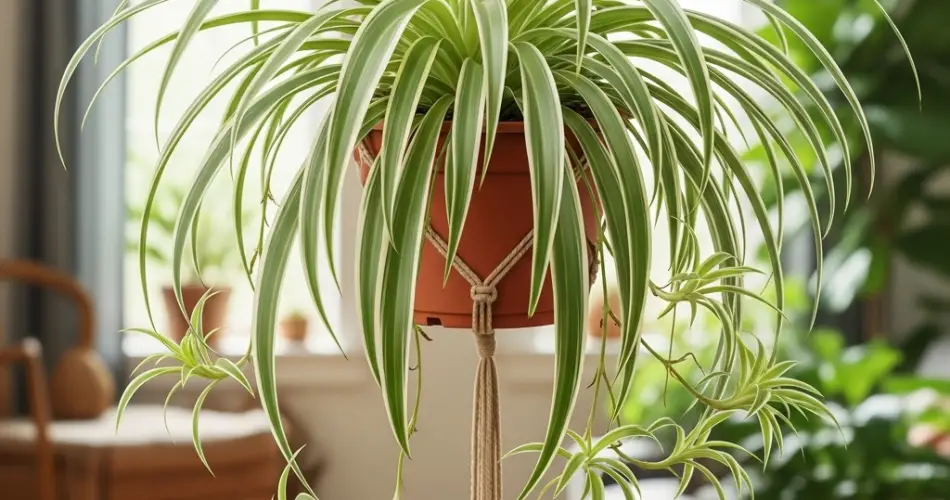Spider plants (Chlorophytum comosum) are known for their resilience and graceful appearance, with arching leaves that cascade beautifully from pots and hanging baskets. Despite their reputation as easy-to-care-for houseplants, even these hardy plants can sometimes show distress. A common issue that worries many plant owners is a drooping spider plant. While drooping leaves may look like a sign of decline, the good news is that this problem can usually be reversed with the right care—most importantly, by adjusting your watering routine.
Why Spider Plants Droop
Drooping in spider plants is almost always related to water—either too much or too little. These plants prefer consistent moisture but dislike being waterlogged. Understanding the balance between hydration and drainage is key to reviving a struggling plant.
-
Underwatering: If the soil becomes too dry for extended periods, the leaves will wilt, curl inward, and lose their firmness.
-
Overwatering: Excess water suffocates the roots, preventing them from absorbing oxygen and nutrients. This leads to root rot, yellowing leaves, and a limp appearance.
-
Environmental factors: Low humidity, sudden changes in temperature, or poor soil drainage can also contribute to drooping.
Identifying which of these is affecting your plant will help determine the right solution.
Step 1: Diagnose the Problem
Before rushing to water, it’s important to assess the soil and roots.
-
Check soil moisture – Insert a finger 1–2 inches into the soil. If it feels dry, underwatering is likely the issue. If it feels soggy or smells musty, overwatering is the culprit.
-
Look at the leaves – Dry, crispy tips often point to underwatering, while yellow, mushy leaves signal overwatering.
-
Inspect the roots – If possible, gently slide the plant from its pot. Healthy roots are white and firm, while rotting roots look brown or black and feel soft.
This simple inspection ensures you don’t worsen the problem with the wrong fix.
Step 2: Reviving an Underwatered Spider Plant
If your spider plant is drooping because it’s too dry, here’s how to restore it:
-
Water thoroughly: Place the pot in a sink or bathtub and water until it drains freely from the bottom. This ensures the entire root ball is rehydrated.
-
Soak for stubborn dryness: If the soil has become compacted and repels water, set the pot in a basin of water for 15–20 minutes to allow the roots to absorb moisture evenly.
-
Establish a routine: Spider plants prefer a soak-and-dry method. Water again only when the top inch of soil feels dry.
Within a few days, you should see the leaves regaining their firmness and vibrancy.
Step 3: Treating an Overwatered Spider Plant
Overwatering requires a gentler, more cautious approach:
-
Let the soil dry: Stop watering immediately and allow the top several inches of soil to dry out before watering again.
-
Check the roots: If root rot is present, trim away the damaged parts with sterilized scissors. Repot the plant in fresh, well-draining soil.
-
Improve drainage: Always use pots with drainage holes, and consider adding perlite or coarse sand to the potting mix to prevent future waterlogging.
Recovery from overwatering may take longer, but as new healthy leaves emerge, the plant will regain its strength.
Step 4: Prevent Future Drooping with a Smart Water Routine
Once your spider plant has recovered, maintaining a consistent watering schedule will prevent drooping from happening again. Keep these guidelines in mind:
-
Follow the soil, not the calendar – Rather than watering on a strict schedule, check the soil’s dryness. Spider plants thrive when watered only after the top inch has dried.
-
Adjust seasonally – During spring and summer, water more frequently as the plant grows actively. In fall and winter, reduce watering since growth slows.
-
Mind humidity – Spider plants prefer moderate humidity. If the air in your home is dry, use a humidifier or place the plant near a tray of water and pebbles to avoid leaf tip browning.
-
Avoid harsh water – Fluoride and chlorine from tap water can harm spider plants, causing drooping and browning tips. Use filtered or distilled water when possible.
Additional Care Tips for Long-Term Health
Watering is the most critical factor in reviving a drooping spider plant, but other care steps can help keep it flourishing:
-
Proper light: Place the plant in bright, indirect light. Too much direct sun can scorch the leaves, while too little light can weaken growth.
-
Repot when necessary: Spider plants grow quickly and can become root-bound, which affects water absorption. Repot every couple of years to refresh the soil and give the roots more space.
-
Regular cleaning: Dust on leaves can block light absorption. Wipe the foliage gently with a damp cloth to keep it clean and healthy.
Final Thoughts
A drooping spider plant may look concerning, but with the right care—especially an appropriate watering routine—it can bounce back quickly. The key is identifying whether your plant is underwatered or overwatered and then adjusting your approach accordingly. By paying attention to soil moisture, maintaining good drainage, and adapting your routine to seasonal changes, you’ll restore your spider plant to its lush, vibrant form.
With consistency and care, your once-drooping plant will thrive again, sending out fresh green leaves and baby plantlets, reminding you why spider plants are considered some of the most rewarding houseplants to grow.



